For orders and inquiries please e-mail
[email protected]
*Architects, designers, and AV producers, alternative mediums are available! Please, inquire!
#1 The Gihon Spring
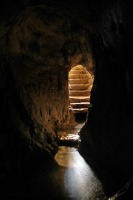
This was the primary water source inside the walls of Salem, the Canaanite mountain fortress called Jebusi. While the water supported life inside the walls and irrigated crops in the Kidron Valley to the east, it is likely the spring's outlet provided access to King David's officer Joab and facilitated the city's capture. David made the fortress his capital, renaming it the City of David. His son Solomon was crowned king by this spring as recorded in the Bible 1 Kings 1:33-34. Solomon enlarged and included the next mountaintop to the north known as Moriah. This is the site where Abraham had shown his willingness to but had been stopped from making a sacrificial offering of his son to the Creator of the universe. The two mountains, now joined made up the royal complex. The lower is the City of David and the upper site of the Temple and seat of the Sanhedrin. The Gihon's abundance made this development possible like no other spring in the area. In fact the spring still provides water to the inhabitants of East Jerusalem and is the name of the Jerusalem water company. These are literally the birth waters of Jerusalem. Interestingly, the first mention of Gihon in the Bible is in Genesis 2:13 as a branch of the river that "went out of Eden to water the garden"
Ultrachrome on archival paper sizes available approx. 5.5"x9.5"- $149 - 18"x28" - $549 plus shipping
Ultrachrome on archival paper sizes available approx. 5.5"x9.5"- $149 - 18"x28" - $549 plus shipping
#2 City of David & Temple Mount
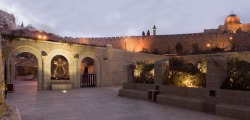
Standing on the site of the royal palace in the City of David entrance plaza, looking north, one sees the south wall of Jerusalem's Old City. The dome on the right is the Al Aksa mosque. It is somewhat less grand than the famous Mosque of Omar ( Dome of the Rock ) but they share the summit of Mount Moriah where both the first and second Jewish temples stood. On this site, one can understand David's desire to be close to the site where his father Abraham was tested. David's conviction to his spiritual idea was deep enough to motivate the conquest of the Jebusite fortress of Zion, not destroy it, make it his capital and initiate the building of the first Temple. A majority of King David's Psalms were written on this site.
Ultrachrome on archival paper sizes available approx. 6"x12" - $149 - 20"x40" - $549 plus shipping
Ultrachrome on archival paper sizes available approx. 6"x12" - $149 - 20"x40" - $549 plus shipping
#3 The Canaanite Pool
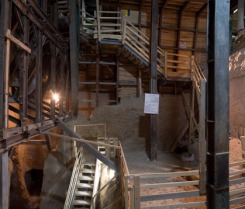
This is a view looking eastward inside the Canaanite pool several meters below the mountain side. The dimensions create a 10 x 15 mtr. rectangular pool about 14 mtrs. deep. A more thorough explanation can be found in the book City of David, the Story of Ancient Jerusalem, also available on photomax.weebly.com.
In an era when people lived closer to the elements than we do today, this site offers a quiet air of sanctity for the human life that it supported. The inhabitants bequeathed their genius and labor to the development of a city that would one day be called holy. One can almost hear the clapping of sandals on the stones around the pool and imagine the water reflecting the laughter of friends at its edge. How many tears did these waters carry into the surrounding desert mountains? How many blessings were uttered in gratitude for this pool which allowed the citizens to survive under siege?
Ultrachrome on archival paper sizes approx. 8"x8" - $149 - 24"x24" - $649 plus shipping
In an era when people lived closer to the elements than we do today, this site offers a quiet air of sanctity for the human life that it supported. The inhabitants bequeathed their genius and labor to the development of a city that would one day be called holy. One can almost hear the clapping of sandals on the stones around the pool and imagine the water reflecting the laughter of friends at its edge. How many tears did these waters carry into the surrounding desert mountains? How many blessings were uttered in gratitude for this pool which allowed the citizens to survive under siege?
Ultrachrome on archival paper sizes approx. 8"x8" - $149 - 24"x24" - $649 plus shipping
#4 The Southeast Corner of the Temple Mount
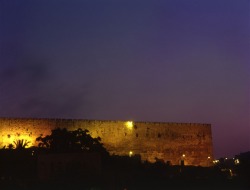
This is a view of the southeast corner of the Temple Mount just before dawn as seen from the City of David. These walls are not from the first or second Temple era. Though there are some small remnants, the Roman Emperor Hadrian effectively destroyed Jerusalem to the ground. However, the walls were restored in the 7th century by Suleiman the Magnificent. He did use much of the stone that had been thrown down from the original walls. In a closer look, one may see that the Herodian cut stones and those of the Hasmonian dynasty are laid intermittently in the same course, for example, not according to their original date. Nevertheless, the site of Jerusalem's walls rebuilt after such devastation and exile of the population, stands as a profound fulfillment of prophetic promises to rebuild Jerusalem.
Ultrachrome on archival paper approx. 7" x 12" - $149 - 20" x 30" - $549
plus shipping
Ultrachrome on archival paper approx. 7" x 12" - $149 - 20" x 30" - $549
plus shipping
#5 Wadi Qelt View
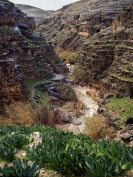
The Wadi Qelt winds eastward through the Judean desert from Jerusalem to Jericho. This is a spring fed gorge much like the Kidron Valley on the east side of Jerusalem between the Temple Mount (Mount Moriah) and the Mount of Olives. The Gihon Spring is just south of Mount Moriah in the City of David and also flows through the Kidron eastward, becoming a raging river in the winter before reaching the Dead Sea. These canyons and water sources with their range of moods from placid insignificance to deadly rage, seem to define the powerful character of the Judean desert mountains. These are the mountains where Jerusalem was born.
Ultrachrome on archival paper approx. 7" X 9" - $149 - 16" x 28" - $549 plus shipping
Ultrachrome on archival paper approx. 7" X 9" - $149 - 16" x 28" - $549 plus shipping
#6 Wadi Qelt Pool
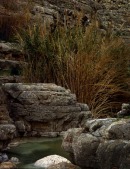
Working in Italy, I was able to understand something of the environment of the line and color that influenced the Renaissance painters. In France I could better understood Cezanne's interpretations of form and Monets's impressions. In these desert mountains, by these streams one shares the inspiration of David " As the hart pants after the water brooks, so my soul pants after thee, O G-d. My soul thirsts for G-d, the living G-d." Psalm 42:1-2
Ultrachrome on archival paper approx. 7' x 9" $149 - 16" x 28" -$549 plus shipping
Ultrachrome on archival paper approx. 7' x 9" $149 - 16" x 28" -$549 plus shipping
#7 Kotel Hakatan
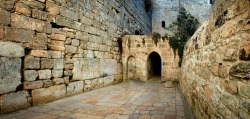
A place of true respite, this small quiet court yard is a meditative haven in the midst of the Old City of Jerusalem's Muslim quarter. On the left is a section of the Western Wall but this section is north of the well known Western Wall plaza. Through the small arch near the center of the photograph 15 meters, on the left, there is a large arched gate with wooden doors. Muslims pass through this gate to what was the First and Second Temple Mount court yard to pray. There, on the 2-3 acre stone plaza, are two mosques, the Mosque of Omar (Dome of the Rock) and the Al Aksa Mosque. Out of respect for the Muslim faith and security, the Israeli authorities require special permission for anyone to visit the Temple Mount. However, Muslims pray five time a day and these are mosques used by the local population. On Fridays, it is quite a beautiful spectacle when a sea of Muslim faces come for prayers. Interestingly, King Solomon dedicated the first Temple on this site as "a house of prayer for all people". Ironically, because observant Jews understand the sanctity of the Temple's environs, many religious authorities dissuade, even forbid Jewish entrance to the site. Jews have prayed for two thousand years for the restoration of King Solomon"s plan for world peace, a time "when any man from any nation would turn his face to this house and pray". 1 Kings 8:38. Meanwhile this beautiful courtyard, a mere remnant of myriad dreams, suggests the need for humility in the anticipation of the grand vision.
Ultrachrome on archival paper approx. 6'x 12" $149 - 20" x 40"- $549 plus shipping
Ultrachrome on archival paper approx. 6'x 12" $149 - 20" x 40"- $549 plus shipping
#8 Olive Tree - Detail
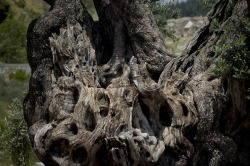
This olive tree was recently transplanted in the City of David. It is believed to be some 500 years old. Through its boughs, one may see a funerary monument known as the Tomb of Zachariah. Both are in the Valley Kidron which runs on the east side of the Temple Mount and the City of David. Both belie or even obscure the real history of the site. The tree is not native nor is the actual identity of the tomb known. But being at this site, they seem to fit. This tree looked to me as if it wanted to give council, the moseleum a reminder of the sanctity of the site. The tree stands in a small field just outside the walls of the Jebusite fortress adjacent to what is believed to be the original burial site of the Davidic dynasty.
Ultachrome on archival paper approx. 7" x 9" $149 - 16" x 28" - $549 plus shipping
Ultachrome on archival paper approx. 7" x 9" $149 - 16" x 28" - $549 plus shipping
#9 Columns in a Pool
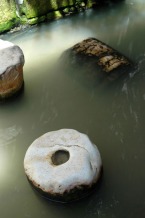
Pieces of Second Temple columns lie broken in this pool once believed to be the Pool of Siloam, so named by the Byzantines. In 2004, the road leading to this site collapsed because of a broken sewer line beneath it. During repairs another, much larger pool was discovered several meters below. While this pool might accommodate two dozen people, the original pool of Shiloah (Siloam) is believed to have accommodated thousands of wordshipers who came to Jerusalem for the holidays three time a year. Today, this small pool is at the exit of Hezikiah's tunnel. Tourists use the area for orientations after traversing the tunnel. Local Arab kids use it for cooling off in the summer. Jewish residents of The City of David emerse themselves each morning before prayers at this site.
Ultrachrome on archival paper approx. 7" x 9" - $149 - 16" x 28" -$649 plus shipping
Ultrachrome on archival paper approx. 7" x 9" - $149 - 16" x 28" -$649 plus shipping
#10 The Pool of Shiloah
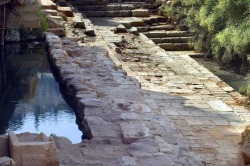
This is one corner of the Pool of Shiloah (Siloam). The entire pool has not yet been excavated as most of it is under a large private garden as well as some local primary roads. Enough has been revealed to understand the centrality of its function as a place of refreshment for visitors to Jerusalem. The small pool at left is assumed to have been for drinking while the larger estimated 50 x 60 mtr. pool was for bathing. While the pool was fed by the Gihon Spring, it was fuller in wet years than in dry years. The steps and landings provided easy access regardless of the depth. The pool also featured a covered prominade supported by the many columns found at the site. In addition, the site being just a few hundred meters down the hill from the Temple, it was likely used as a mikve, Jewish ritual bath, in preparation to bring offerings on the Holidays.
Ultrachrome on archival paper approx. 7" x 9" - $149 - 16" - 28" - $549 plus shipping
Ultrachrome on archival paper approx. 7" x 9" - $149 - 16" - 28" - $549 plus shipping
#11 The Harvest
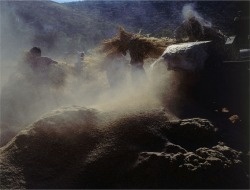
The Land of Israel is replete with images which seem to hark back to Biblical times. We in the west tend to relate to people who work the land as perhaps more G-d fearing due to their daily reliance on the elements for their success. The faceless figures in this image seem to give it a universality. It seems to imply a timeless reliance on fundamentals as well as the noble cause of partnering with the Creator to put food on the table.
Ultrachrome on archival paper approx, 8" x !4" $249 - 24" x 32" $1199 plus shipping
Ultrachrome on archival paper approx, 8" x !4" $249 - 24" x 32" $1199 plus shipping
#12 Pomegranates & Roses In The City of David
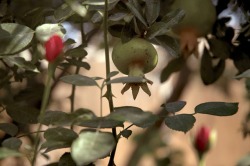
Not much new could be said about the beauty of a rose. "A rose arose. Beauty grows". However, the pomegranate holds special significance in the Jewish tradition. It is said that we should have as many good deeds as the pomegranate is filled with seeds. Ripening about the time of the Jewish New Year, it is a prominent symbol for Rosh Hashanah. A central theme of this High Holiday is how our actions have an effect on this world and knowing we have the ability to change it for the better. How appropriate to find pomegranates growing with roses where some of the world's most beloved verses were written? This scene seems to convey much of what David, the Psalmist King and his son, the wise King Solomon perceived as true beauty. This photograph was made on the very site of the royal palace in the City of David. The golden glow of Jerusalem's walls can be seen in the background.
Ultrachrome on archival paper approx. 7" x 9" - $149 - 16" x 28" $549 plus shipping
Ultrachrome on archival paper approx. 7" x 9" - $149 - 16" x 28" $549 plus shipping
#13 Ohr ha-Chaim Hakadosh Synagogue
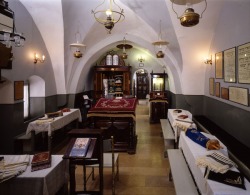
Rabbi Chaim Ibn Attar immigrated to Jerusalem in 1742 from Morocco. Stopping in Livorno on his way, he raised money enough to publish several of his writings and bring students with him to open a yeshiva (academy for Torah study).This synagogue in Jerusalem's Old City, was the original study hall and is named for his magnum opus titled Ohr ha-Chaim (Light of Life). It is a commentary on the five books of Moses that is enjoyed by the full spectrum of observant Jews today. This synagogue is a testament to the rabbi's piety and dedication to Jews of all backgrounds. Though he was of Sephardi origins, the synagogue is now used by an Ashkenazi community. It is lovingly cared for by the Weingarten family whose home is in the same building along with a museum of the Jewish quarter. Interestingly, the Arizal, well known spiritual leader and kabbalist, was born on the lower floor. Rabbi Attar was a Talmudist and Kabbalist. The Ba'al Shem Tov once commented that he was the Mashiach of his generation. This humble house of meeting would hardly suggest such a universal influence. Clearly, the Light of Life is Rabbi Chaim Ibn Attar's legacy.
Ultrachrome on archival paper approx. 5.5" x 7" - $149 - 48" x 60" $1299 plus shipping
Ultrachrome on archival paper approx. 5.5" x 7" - $149 - 48" x 60" $1299 plus shipping
#14 Butterfly, City of David
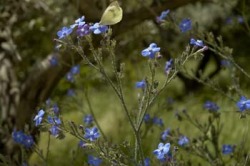
The single butterfly and the blue of the wild flowers are a reminder to the photographer of Israel's uniqueness and often overlooked beauty among the nations. The City of David covers an area of only a few acres. This small, almost forgotten site, now being rediscovered and restored, has provided us with some of the world's most enduring beauty in the Psalms of David and the wisdom of Solomon. "May the words of my mouth and the meditations of my heart be acceptable in your sight, O Lord, my rock and my redeemer." Psalm 19:15
Ultrachrome on archival paper approx 7" x 9" - $149 - 16" x 28" - $549 plus shipping
Ultrachrome on archival paper approx 7" x 9" - $149 - 16" x 28" - $549 plus shipping
#15 Western Wall Detail
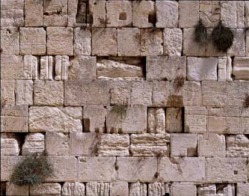
In 37 C.E. Herod the Great expanded the entire top of Mt. Moriah and made a large plaza to accommodate the Temple and Sanhedrin complex. This is a section of the western retaining wall.
How can an inanimate wall of stone be at or near the center of global conflict for 2000 years? The thoughts of prince and pauper, king and subject, priest, president and all echelon of folk have been arranged in this place? Hasn't it heard every praise and plea, problem and proposal, promise and prayer? Perhaps its secrets are its sanctity. It's silence its strength. But its purpose is not completely concealed. I see it. I feel its stones. I am renewed by its aged face. Hope is restored, as if I am young again. It has endured and so will I. Only silent stones could withstand so much adversity and sadness, so much time that may only be shared with these stones, time no single human has seen. Perhaps it is the shared history of us all we see in these stones. If they could hear and speak, would they tell us, you have spoken now go and do all that you have spoken?
Ultrachrome on archival paper approx 5.5" x 7" - $149 - 48" x 60" - $1299
How can an inanimate wall of stone be at or near the center of global conflict for 2000 years? The thoughts of prince and pauper, king and subject, priest, president and all echelon of folk have been arranged in this place? Hasn't it heard every praise and plea, problem and proposal, promise and prayer? Perhaps its secrets are its sanctity. It's silence its strength. But its purpose is not completely concealed. I see it. I feel its stones. I am renewed by its aged face. Hope is restored, as if I am young again. It has endured and so will I. Only silent stones could withstand so much adversity and sadness, so much time that may only be shared with these stones, time no single human has seen. Perhaps it is the shared history of us all we see in these stones. If they could hear and speak, would they tell us, you have spoken now go and do all that you have spoken?
Ultrachrome on archival paper approx 5.5" x 7" - $149 - 48" x 60" - $1299
